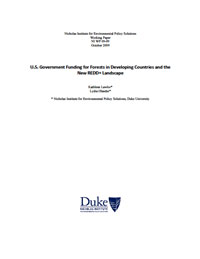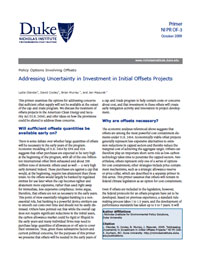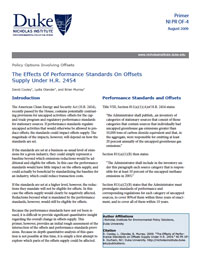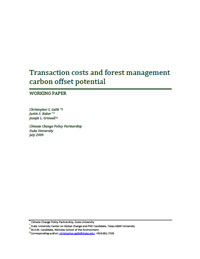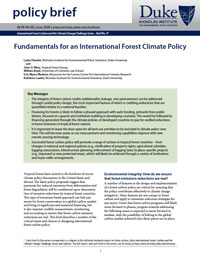Publications
Policy Options for Transitioning from Voluntary to Federal Offsets Markets
This primer examines the options for transitioning from the current diversified voluntary offsets market to a more standardized federal offsets program expected as part of an economy-wide cap-and-trade program. It was developed with input from a working group on offsets transition that first met in August 2009 as part of a broader effort by the Nicholas Institute to convene researchers, Congressional staff, and various stakeholders to explore ways of containing the overall cost of climate legislation.
Sticking Points in Offsets Policy
As the U.S. congressional debate about climate policy matures, the design of a carbon offsets program has become increasingly central to the debate. Offsets have attracted the support of a number of stakeholders because of their promise to provide low-cost, flexible compliance in a carbon trading scheme. They have also evoked a number of concerns in the political discourse, as stakeholders have made different judgments about how to balance the assurance of performance with the efficient administration of the program. This primer outlines and compares a range of policy options that would address key issues in offsets policy in a greenhouse gas cap-and-trade system.
Forging a Path for High-Quality Compliance REDD Credits
Concerns over the potential for catastrophic climate change drive the call for significant reductions, 50 to 80 percent by mid-century, in the concentration of greenhouse gases in the atmosphere. With 15-20 percent of current greenhouse gases resulting form forest clearing, it would be nearly impossible to meet these long-term goals without addressing the forest problem. As a result, most policy initiatives to address forests' role in climate change mitigation involved developed countries financing much or most of the reductions, at least initially.
U.S. Government Funding for Forests in Developing Countries and the New REDD+ Landscape
The United States has long been involved in tropical forest conservation, through both bilateral and multilateral initiatives. The U.S. Congress is considering climate legislation that would establish programs to reduce emissions from deforestation and forest degradation and that would conserve and restore forests in developing countries. If adopted, these programs would dramatically increase U.S. government assistance for tropical forest conservation and sustainable development. Climate legislation under debate would increase U.S.
Addressing Uncertainty in Investment in Initial Offsets Projects
This primer examines the options for addressing concerns that sufficient offset supply will not be available at the outset of the cap-and-trade program. It discusses the treatment of offset projects in the American Clean Energy and Security Act (H.R. 2454) and offers ideas on how the provisions could be altered to address these concerns.
Document
Primer on H.R. 2454: Offsets
In cap-and-trade systems, uncapped or unregulated sectors can reduce greenhouse gas emissions or increase carbon sequestration. Voluntary greenhouse gas emission reductions or sequestered carbon by uncapped entities can then be translated into a commodity (i.e., a carbon offset), which capped entities can purchase to satisfy their emissions compliance requirements if making internal reductions is too difficult, cost-prohibitive, or both. This primer explains the necessity for offsets the strengths and shortcomings of Waxman-Marley’s offset provisions.
The Effects of Performance Standards on Offsets Supply Under H.R. 2454
The American Clean Energy and Security Act (H.R. 2454), recently passed by the House, contains potentially contrasting provisions for uncapped activities: offsets for the cap-and-trade program and regulatory performance standards for stationary sources. If performance standards regulate uncapped activities that would otherwise be allowed to produce offsets, the standards could impact offsets supply. The magnitude of the impacts, however, will depend on how the standards are set. This primer provides an initial rough assessment of the intersection of the offsets and performance standards provisions. Because in-depth quantitative analysis of this question is not possible at this time, it is simply a first attempt to explore which parts of the offsets supply could be affected.
Transaction Costs and Forest Management Carbon Offset Potential
Transaction costs are one of the key challenges that private forest landowners may face in participating in emerging carbon markets. As most forestlands in the United States occur in the form of small, privately held landholdings, the supply of forest carbon offsets could be constrained by high transaction costs. Using a custom spreadsheet model, this study examines the transaction costs of different forest offset projects operating in different forest types under different accounting methodologies. Results suggest that transaction costs can be signficant for small forest management offset projects.
Fundamentals for an International Forest Climate Policy
Tropical forests have moved to the forefront of recent climate policy discussions in the United States and abroad. The latest policy proposals suggest that payments for reduced emissions from deforestation and forest degradation will be conditional upon demonstration of emission reductions by tropical forest countries. This type of emissions-based approach can link payments for forest conservation to a global carbon market and bring in signficant and sustained financing, but it also requires credible measurement, monitoring, and accounting to ensure that forest carbon emission reductions are real. This brief describes a number of the critical issues and choices in designing international forest carbon policy.
Responding to Concerns and Questions
Efforts to include emissions from deforestation and forest degradation in climate policy have gained considerable traction in recent years in the United States and abroad. With mounting evidence that atmospheric carbon dioxide concentrations cannot be stabilized at a prudent level without addressing emissions from the forest sector, policy makers are actively seeking ways to integrate international forest carbon into existing and emerging greenhouse gas compliance regimes. This brief addresses common criticisms and outstanding questions regarding the inclusion of forest carbon in climate policy.




